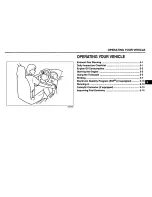
Driving
vehicle to a specialised workshop as soon as
possible.
If there is a fault in the ABS, the ESC* and the
tyre pressure control lamp will also light up.
Brake system fault
If the ABS warning lamp
lights up together
with the brake warning lamp
, there is a
fault in the ABS function and in the brake sys-
tem
WARNING
●
The anti-lock brake system cannot defy
the laws of physics. Slippery and wet roads
are dangerous even with ABS! If you notice
that the ABS is working (to counteract
locked wheels under braking), you should
reduce speed immediately to suit the road
and traffic conditions. Do not let the extra
safety features tempt you into taking any
risks when driving.
●
The effectiveness of ABS is also deter-
mined by the tyres fitted
●
If the running gear or brake system is
modified, the effectiveness of the ABS
could be severely limited.
WARNING
●
Before opening the bonnet, read and ob-
serve the warnings
●
If the brake system warning lamp
should light up together with the ABS warn-
ing lamp
, stop the vehicle immediately
and check the brake fluid level in the reser-
voir
. If the brake
fluid level has dropped below the “MIN”
mark you must not drive on. Risk of acci-
dent. Obtain technical assistance.
●
If the brake fluid level is correct, the fault
in the brake system may have been caused
by a failure of the ABS system. This could
cause the rear wheels to lock quickly when
you brake. This could cause the rear to
break away. Risk of skidding. Stop the vehi-
cle and seek technical assistance.
Hydraulic Brake Assist*
The Hydraulic Brake Assist is only included in
vehicles with ESC.
In an emergency, most drivers brake in time,
but not with maximum force. This results in
unnecessarily long braking distances.
This is when the brake assist system comes
into action. When pressing the brake pedal
rapidly, the assistant interprets it as an emer-
gency. It very quickly builds up the full brake
pressure so that the ABS can be activated
more quickly and efficiently, thus reducing
braking distance.
Do not reduce the pressure on the brake ped-
al, since the brake assist system switches off
automatically as soon as you release the
brake.
Automatic hazard warning lights activa-
tion
The brake lights flash automatically to indi-
cate that the vehicle is braking suddenly or in
an emergency situation. If the emergency
braking continues until the vehicle comes to a
standstill, the hazard
“warning”
lights will
then come on and the brake lights will remain
on permanently from that moment. The
warning lights will automatically switch off
when the vehicle begins to move again or
when the "warning" light button is pressed.
WARNING
●
The risk of accident is higher if you drive
too fast, if you do not keep your distance
from the vehicle in front, and when the road
surface is slippery or wet. The increased
accident risk cannot be reduced by the
brake assist system.
●
The brake assist system cannot defy the
laws of physics. Slippery and wet roads are
dangerous even with the brake assist sys-
tem! Therefore, it is essential that you ad-
just your speed to suit the road and traffic
conditions. Do not let the extra safety fea-
tures tempt you into taking any risks when
driving.
230
Summary of Contents for Arona 2018
Page 1: ...Owner s manual SEAT Arona 6F9012720BD Inglés 6F9012720BD 11 18 SEAT Arona Inglés 11 18 ...
Page 16: ...The essentials Interior view page 19 page 19 page 146 page 27 1 2 3 4 page 19 page 22 5 6 14 ...
Page 102: ...Operation Fig 115 Dash panel 100 ...
Page 355: ...Technical specifications Vehicle data Dimensions Fig 289 Dimensions and angles 353 ...
Page 372: ...Owner s manual SEAT Arona 6F9012720BD Inglés 6F9012720BD 11 18 SEAT Arona Inglés 11 18 ...















































